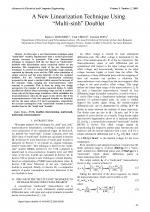| 2/2009 - 8 |
A New Linearization Technique Using Multi-sinh DoubletBOZOMITU, R. G. |
| View the paper record and citations in |
| Click to see author's profile in |
| Download PDF |
Author keywords
CCII, doublet, linearization, multi-tanh, multi-sinh, transconductor
References keywords
circuits(7), mode(4), gain(4), current(4), analog(4)
No common words between the references section and the paper title.
About this article
Date of Publication: 2009-06-02
Volume 9, Issue 2, Year 2009, On page(s): 45 - 57
ISSN: 1582-7445, e-ISSN: 1844-7600
Digital Object Identifier: 10.4316/AECE.2009.02008
Web of Science Accession Number: 000268723600008
SCOPUS ID: 70349391115
Abstract
In this paper a new linearization technique using multi-sinh doublet, implemented with a second generation current conveyor is presented. This new linearization technique is compared with the one based on multi-tanh doublets with linearization series connected diodes on the branches. The comparative study of the two linearization techniques is carried out using both dynamic range analysis, expressed by linearity error and the THD value calculation of output current, and the noise behavior of the two analyzed doublets. For the multi-sinh linearization technique proposed in the paper a method which assures the increase of the dynamic range, keeping the transconductance value constant is presented. This is done by using two design parameters: the number of series connected diodes N, which specifies the desired linear operating range and the k emitters areas ratio of the input stage transistors, which establishes the transconductance value. In the paper is also shown that if the transconductances of the two analyzed doublets are identical, and for the same values of N and k parameters, respectively, the current consumption of the multi-sinh doublet is always smaller than for the multi-tanh doublet. |
| References | | | Cited By |
Web of Science® Times Cited: 8 [View]
View record in Web of Science® [View]
View Related Records® [View]
Updated 2 days, 14 hours ago
SCOPUS® Times Cited: 8
View record in SCOPUS® [Free preview]
View citations in SCOPUS® [Free preview]
[1] The Analysis of the Polaroid Optocoupler Mechanical-electrical Sensor, CIURUS, I. M., DIMIAN, M., GRAUR, A., Advances in Electrical and Computer Engineering, ISSN 1582-7445, Issue 4, Volume 10, 2010.
Digital Object Identifier: 10.4316/aece.2010.04005 [CrossRef] [Full text]
[2] An Electronically Tunable Transconductance Amplifier for Use in Auditory Prostheses, FARAGO, P., FARAGO, C., OLTEAN, G., HINTEA, S., Advances in Electrical and Computer Engineering, ISSN 1582-7445, Issue 4, Volume 15, 2015.
Digital Object Identifier: 10.4316/AECE.2015.04013 [CrossRef] [Full text]
[3] VLSI Design of a 5th-order Gm-C Low-Pass Active Filter in CMOS Technology, Zara, Aurica, Bozomitu, Radu Gabriel, 2021 IEEE 27th International Symposium for Design and Technology in Electronic Packaging (SIITME), ISBN 978-1-6654-2110-2, 2021.
Digital Object Identifier: 10.1109/SIITME53254.2021.9663685 [CrossRef]
[4] A new differential CCII transconductor with increased linearity in bipolar technology, Bozomitu, R. G., Cehan, Vl., ISSCS 2011 - International Symposium on Signals, Circuits and Systems, ISBN 978-1-61284-944-7, 2011.
Digital Object Identifier: 10.1109/ISSCS.2011.5978692 [CrossRef]
[5] Modelling and simulation of a high-voltage direct current ballistic circuit breaker, Dobrej, Robert Alexandru, Oles, Iulian, Negrescu, Cristian, Stanomir, Dumitru, 2016 39th International Spring Seminar on Electronics Technology (ISSE), ISBN 978-1-5090-1389-0, 2016.
Digital Object Identifier: 10.1109/ISSE.2016.7563215 [CrossRef]
Disclaimer: All information displayed above was retrieved by using remote connections to respective databases. For the best user experience, we update all data by using background processes, and use caches in order to reduce the load on the servers we retrieve the information from. As we have no control on the availability of the database servers and sometimes the Internet connectivity may be affected, we do not guarantee the information is correct or complete. For the most accurate data, please always consult the database sites directly. Some external links require authentication or an institutional subscription.
Web of Science® is a registered trademark of Clarivate Analytics, Scopus® is a registered trademark of Elsevier B.V., other product names, company names, brand names, trademarks and logos are the property of their respective owners.
Faculty of Electrical Engineering and Computer Science
Stefan cel Mare University of Suceava, Romania
All rights reserved: Advances in Electrical and Computer Engineering is a registered trademark of the Stefan cel Mare University of Suceava. No part of this publication may be reproduced, stored in a retrieval system, photocopied, recorded or archived, without the written permission from the Editor. When authors submit their papers for publication, they agree that the copyright for their article be transferred to the Faculty of Electrical Engineering and Computer Science, Stefan cel Mare University of Suceava, Romania, if and only if the articles are accepted for publication. The copyright covers the exclusive rights to reproduce and distribute the article, including reprints and translations.
Permission for other use: The copyright owner's consent does not extend to copying for general distribution, for promotion, for creating new works, or for resale. Specific written permission must be obtained from the Editor for such copying. Direct linking to files hosted on this website is strictly prohibited.
Disclaimer: Whilst every effort is made by the publishers and editorial board to see that no inaccurate or misleading data, opinions or statements appear in this journal, they wish to make it clear that all information and opinions formulated in the articles, as well as linguistic accuracy, are the sole responsibility of the author.





